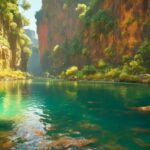Get ready to embark on an enlightening journey through the captivating world of coastal plains! In the article, “Discover Fascinating Coastal Plain Facts: A Treasure Trove of Ecological Wonders!”, we delve into the mesmerizing realm of these unique landforms and unravel the astonishing ecological wonders that they harbor. From their geological origins to the diverse ecosystems they sustain, we’ll explore the intricate tapestry of coastal plains and shed light on their immense ecological significance. Brace yourself for a fascinating exploration of these invaluable natural landscapes!
Key Takeaways:
- Coastal plains are flat, low-lying land adjacent to a coastline.
- They are separated from the interior by nearby landforms like mountains.
- In the United States, coastal plains can stretch up to 1,500 miles long and vary in width from 100 to 200 miles.
- Different types of soils, plants, and animals can be found in coastal plains, influenced by the climate and location.
- Coastal plains can form through the accumulation of sediment from rivers or by the rising of the sea level.
- India has coastal plains known as the Western Coastal Plain and the Eastern Coastal Plain, located on both sides of the Deccan Plateau.
Facts About Coastal Plains

If you’ve ever stood on a sandy beach, you’ve experienced the coastal plain, a remarkable landform with fascinating ecological wonders. Let’s delve into some intriguing facts about coastal plains and discover the hidden treasures they hold.
Flatlands Along the Coast
Coastal plains are expansive stretches of flat, low-lying land that lie adjacent to a sea coast. They extend along the shoreline and are separated from the interior by nearby landforms like mountains. These plains can be found all around the world, from the United States to India, each with its own unique characteristics.
Impressive Size and Diversity
In the United States alone, coastal plains span an impressive length of approximately 1,500 miles. Their width can vary too, stretching from 100 to 200 miles. This vast expanse harbors a wealth of diverse ecosystems, influenced by the local climate and geographic location. These ecosystems range from marshes and wetlands to forests and grasslands, supporting a rich array of plant and animal life.
The Lure of Sediment and Sea Level
Coastal plains form through two primary processes: the accumulation of sediment from rivers or the rising of the sea level. When rivers transport sediments, they deposit them along the coast, gradually building up the flat terrain of the coastal plain. Over time, this accumulation creates the characteristic flatness that defines these plains.
Sea level rise is another driving force in coastal plain formation. As the sea level increases, it expands onto the adjacent land, ultimately creating new expanses of coastal plain. The interplay between these two processes crafts the intricate tapestry of coastal plains we see today.
Nature’s Masterpiece: The Indian Coastal Plains
The beauty of coastal plains can be witnessed in various locations around the globe. In India, two remarkable examples are the Western Coastal Plain and the Eastern Coastal Plain, which flank the Deccan Plateau. The Western Coastal Plain stretches along the Arabian Sea, while the Eastern Coastal Plain lies adjacent to the Bay of Bengal. These picturesque landscapes, with their lush vegetation, offer glimpses into the diverse ecological wonders of coastal plains.
Let’s summarize the remarkable facts about coastal plains:
- Coastal plains are flat, low-lying lands located along the sea coast, separated from the interior by nearby landforms.
- In the United States alone, coastal plains span about 1,500 miles and vary in width from 100 to 200 miles.
- Coastal plains form through the accumulation of sediment from rivers or the rising of the sea level.
- The Western Coastal Plain and the Eastern Coastal Plain in India showcase the unique beauty of coastal plains.
So, the next time you find yourself near a coast, take a moment to appreciate the wonders of the coastal plains. These magnificent landscapes are not only visually captivating but also serve as vital habitats for numerous species. Embrace this enlightening journey into the realm of coastal plains and discover the treasures that lie within their expanses. Cherish and protect these invaluable natural wonders for generations to come.
References:
Here are some fascinating links to explore:
- Facts on Architecture: Discover interesting facts about the world of architecture, from ancient wonders to modern marvels.
- Facts about the Coastal Plains: Dive into the intriguing world of coastal plains and learn about their unique features and importance.
- Facts about Macarons: Indulge yourself in the sweet world of macarons and uncover fascinating facts about these delicate treats.
- Facts about Karnak Temple: Step back in time and explore the secrets of the magnificent Karnak Temple, an architectural masterpiece.
- Facts about Churros: Take a delicious journey into the world of churros and uncover interesting facts about these mouthwatering treats.
- Facts about Boba: Dive into the trendy world of boba and discover intriguing facts about this popular beverage and its origins.
- Facts about Slime: Dive into the squishy and colorful world of slime and learn fun facts about this popular sensory toy.
- Interesting Facts about the Maya Civilization: Uncover captivating facts about the ancient Maya civilization and their rich culture and achievements.
- Interesting Facts about Chad: Discover fascinating facts about Chad, a diverse country in Central Africa, with a unique blend of natural wonders and cultural heritage.
- Dessert Facts: Treat yourself to a sweet adventure and explore interesting facts about various desserts from around the world.
Happy clicking and exploring!
Biodiversity in Coastal Plain Ecosystems
Coastal plains are not just picturesque landscapes; they are teeming hubs of biodiversity that support a remarkable array of species. From stunning coral reefs to vital mangrove forests and bustling estuaries, coastal ecosystems offer a treasure trove of ecological wonders. In this article, we delve into the fascinating world of biodiversity in coastal plain ecosystems, uncovering the unique features and challenges faced by these critical habitats.
The Abundance of Life in Coastal Plain Ecosystems
Coastal zones act as a haven for biodiversity, housing both land and marine ecosystems. These habitats provide a home to nearly half of the world’s human population, which also highlights the immense anthropogenic pressure placed on coastal biodiversity (MDPI). With their rich abundance of flora and fauna, coastal ecosystems captivate researchers and nature enthusiasts alike.
Coastal Plains: An Integral Component
Coastal plains, the flat and low-lying areas adjacent to the ocean, play a vital role in shaping coastal ecosystems (National Geographic Society). Spanning approximately 1,500 miles in the United States alone and varying in width from 100 to 200 miles, these plains form through the accumulation of sediment from rivers or the rising of sea levels (NOAA’s National Ocean Service, USGS.gov).
Diverse Coastal Ecosystems
Within coastal plains, diverse ecosystems flourish, each presenting a unique collection of species and ecological dynamics. Let’s explore some of these breathtaking ecosystems:
- Mangroves – These salt-tolerant trees serve as nurseries for a wide variety of marine life and act as a buffer against coastal erosion (ScienceDirect).
- Estuaries – The meeting point of rivers and oceans, estuaries boast rich biodiversity and provide crucial habitat to countless species (ScienceDirect).
- Coral Reefs – Often referred to as the “rainforests of the sea,” coral reefs are home to a mind-boggling array of marine species. However, they are currently facing significant threats (NOAA’s National Ocean Service).
- Seagrass Beds – These underwater meadows support an astonishing diversity of marine life, playing an essential role in coastal food webs (NOAA’s National Ocean Service).
- Beaches – Though often associated with relaxation, sandy beaches are vibrant habitats supporting various organisms, including nesting sea turtles and shorebirds (NOAA’s National Ocean Service).
Challenges to Coastal Biodiversity
While coastal ecosystems are renowned for their biodiversity, they face numerous threats that jeopardize their delicate balance. Anthropogenic activities such as habitat destruction, pollution, overfishing, and climate change pose significant challenges to the long-term survival of these ecosystems (Wiley Online Library). Urgent action is required to ensure the conservation and sustainable management of coastal plain biodiversity.
Key Takeaways:
- Coastal plains are flat, low-lying lands adjacent to the ocean, shaping coastal ecosystems.
- Biodiversity in coastal plain ecosystems is of immense ecological importance, housing diverse flora and fauna.
- Mangroves, estuaries, coral reefs, seagrass beds, and beaches are examples of vibrant coastal ecosystems.
- Coastal biodiversity faces threats from human activities and climate change.
- Conservation and sustainable management efforts are crucial to the survival of coastal plain ecosystems.
For more information on coastal biodiversity, visit:
- MDPI – Biodiversity and Human Well-Being in Coastal Zones
- Wiley Online Library – Biodiversity in Coastal and Marine Environments
References:
- MDPI. (n.d.). Biodiversity and Human Well-Being in Coastal Zones. Retrieved from Source
- National Geographic Society. (n.d.). Coastal Plain. Retrieved from Source
- NCBI. (n.d.). Coastal Ecosystems and Global Change. Retrieved from Source
- ScienceDirect. (n.d.). Coastal Ecosystems. Retrieved from Source
- JSTOR. (n.d.). Coastal Ecosystems. Retrieved from Source
- CBD. (n.d.). Value and Safeguarding of Coastal Biodiversity. Retrieved from Source
- Wiley Online Library. (n.d.). Biodiversity of Coastal Marine Ecosystems. Retrieved from Source
- USGS. (n.d.). Coastal Ecosystems Program. Retrieved from Source
- NOAA’s National Ocean Service. (n.d.). Why are Coastal Ecosystems Important. Retrieved from Source
- NOAA’s National Ocean Service. (n.d.). What is a Coral Reef?. Retrieved from Source
Human Impact and Threats to Coastal Plains
Coastal plains, with their remarkable beauty and ecological significance, are facing a myriad of challenges that pose significant threats to their ecosystems and nearby communities. These problems are predominantly a result of human activities and natural phenomena, and their consequences can have far-reaching implications for coastal areas. Let’s delve into some of the major issues affecting coastal plains and explore their implications.
Climate Change: A Rising Threat
Key Information:
– Climate change is a critical issue affecting coastal areas worldwide.
– Increased frequency and intensity of extreme weather events, such as storms, hurricanes, and cyclones, pose a significant threat to coastal plains.
– These events can cause severe damage to infrastructure, pose risks to human safety, and disrupt coastal and marine ecosystems.
– Climate change exacerbates existing problems in these areas, including pollution, invasive species, and coastal erosion.
Rising Sea Levels: A Looming Concern
Key Information:
– One of the most pressing issues faced by coastal plains is sea-level rise.
– As global temperatures continue to rise, ice caps and glaciers melt, leading to an increase in sea levels.
– This rise can erode coastal ecosystems, submerge low-lying areas, and eliminate crucial wetlands.
– The loss of these habitats disrupts coastal biodiversity, impacts economies, and increases vulnerability to flooding and storm surges.
Warmer Oceans and Acidification: Impacts on Marine Life
Key Information:
– The warming of ocean waters and increased acidity due to human-induced climate change pose significant risks to coastal and marine ecosystems.
– Rising water temperatures can lead to coral bleaching events, affecting vital coral reef ecosystems.
– Acidification disrupts the growth and reproduction of shell-forming organisms, impacting the food chain and ecosystem dynamics.
– These changes in coastal and marine ecosystems have severe consequences for fisheries, tourism, and overall ecosystem health.
Coastal Development: A Balancing Act
Key Information:
– The rapid growth of coastal development has profound implications for coastal areas.
– Construction of infrastructure, such as ports, cities, and resorts, can lead to increased erosion, habitat loss, and reduced climate change resilience.
– Destruction of sensitive habitats, such as mangroves and salt marshes, undermines storm protection, water filtration, and species’ habitat.
– Alteration of coastal landscapes disrupts natural processes, leading to long-term ecological imbalances.
The Nutrient Overload: Eutrophication
Key Information:
– Eutrophication refers to excessive nutrient input, including nitrogen and phosphorus, into coastal areas.
– Nutrient pollution from wastewater treatment facilities, agricultural runoff, and atmospheric deposition leads to harmful algal blooms, oxygen depletion, and dead zones.
– These consequences have detrimental effects on marine and coastal ecosystems, including fish kills, loss of biodiversity, and decreased water quality.
Habitat Modification: Disrupting Nature’s Balance
Key Information:
– Human activities, such as dredging, land reclamation, and coastal infrastructure construction, lead to habitat modification.
– These modifications disrupt natural coastal processes, sediment transport, erosion patterns, and species migration and breeding.
– The loss and degradation of habitats like mangrove forests and salt marshes have significant ecological consequences, reducing coastal resilience.
Disruption of Hydrology and Dynamics
Key Information:
– Human activities, like dam construction and altered river flow, disrupt natural hydrologic and hydrodynamic processes in coastal areas.
– These disruptions lead to changes in sedimentation patterns, altered coastal currents, and loss of natural floodplain functions.
– Such changes can have severe implications for coastal ecosystems, including increased erosion, reduced sediment input, and loss of habitat connectivity.
Exploitation of Resources: Ecological Imbalances
Key Information:
– Coastal areas hold valuable natural resources like fisheries, minerals, and fossil fuels, leading to their overexploitation.
– Overfishing, destructive practices, and unsustainable extraction disrupt ecological balances and deplete key species.
– Impacts include collapsed fisheries, loss of biodiversity, and disruption of ecological processes, affecting local economies and livelihoods.
Toxic Effects: Polluted Coastal Waters
Key Information:
– Various human activities, such as industrial discharges and agricultural runoff, introduce toxic substances into coastal ecosystems.
– Toxic pollutants from point and non-point sources accumulate in coastal waters, harming aquatic and terrestrial organisms.
– Impacts include reduced reproductive success, impaired immune systems, and increased susceptibility to diseases.
Key Takeaways:
– Climate change, sea-level rise, warmer and more acidic oceans, coastal development, eutrophication, habitat modification, hydrologic and hydrodynamic disruption, exploitation of resources, and toxic effects are among the major human impacts and threats to coastal plains.
– These challenges endanger ecosystems and communities, requiring a holistic approach incorporating sustainable coastal management practices, conservation efforts, and climate change adaptation strategies.
References:
– Climate Impacts on Coastal Areas – US EPA. (n.d.). Retrieved April 15, 2023, from 19january2017snapshot.epa.gov/climate-impacts/coastal-impacts-and-adaptation-coastal-zones-1.html
– Major Coastal Environmental Issues. (n.d.). Retrieved April 15, 2023, from nap.nationalacademies.org/read/4932/chapter/4
– Degradation of Coastal Ecosystems: Causes, Impacts and Mitigation. (n.d.). Retrieved April 15, 2023, from researchgate.net/publication/318160356_Degradation_of_Coastal_Ecosystems_Causes_Impacts_and_Mitigation
– Human Impact on Coasts. (n.d.). Retrieved April 15, 2023, from link.springer.com/referenceworkentry/10.1007/978-3-319-53368-1_190
– Stressed out: mapping the human footprint on coastal areas. (n.d.). Retrieved April 15, 2023, from science.uq.edu.au/article/2023/03/stressed-out-mapping-human-footprint-coastal-areas
Conservation Efforts and the Future of Coastal Plains
As our understanding of the ecological significance of coastal plains deepens, it becomes increasingly clear that urgent conservation efforts are essential to safeguard their future. Coastal plains, characterized by their low-lying landscape and adjacency to the ocean, boast a rich tapestry of ecosystems and provide invaluable services to the planet. However, numerous threats loom large, including habitat destruction, pollution, overfishing, and climate change. To ensure the preservation of these remarkable natural landscapes, concerted actions and sustainable management strategies must be implemented.
Protecting Fragile Ecosystems for Future Generations
Conservation organizations like the National Geographic Society are at the forefront of safeguarding fragile ecosystems in coastal plains. By engaging with explorers and researchers, they gain valuable insights into these ecosystems’ intricacies and develop innovative methods for their protection. The National Geographic Museum serves as an educational destination, inspiring visitors to become advocates for conservation efforts.
To further conservation initiatives, the Conservation Gateway provides vital information on the South Atlantic Coastal Plain Ecoregion Plan. This comprehensive plan outlines strategies for preserving the unique biodiversity and ecosystem services offered by the coastal plain.
Enhancing Community and Ecosystem Resilience
The restoration and conservation of coastal ecosystems offer benefits beyond biodiversity preservation. By protecting these vital habitats, we can enhance community and ecosystem resilience to climate change. Coastal areas are particularly vulnerable to rising sea levels, extreme weather events, and erosion. Restoring and conserving these ecosystems can mitigate the impacts of climate change and protect coastal communities from devastation.
A Call to Action for Sustainable Coastal Management
The future of coastal plains depends on our ability to embrace sustainable coastal management practices. By reducing human impacts such as habitat destruction, pollution, and overexploitation of resources, we can foster the long-term health and productivity of coastal ecosystems. Additionally, climate change adaptation strategies should be implemented to address the challenges posed by rising sea levels and changing climatic conditions.
Key Takeaways:
- Conservation efforts are crucial for preserving the future of coastal plains.
- Organizations like the National Geographic Society play a vital role in protecting and studying fragile ecosystems in coastal plains.
- Knowledge-sharing platforms like the Conservation Gateway provide valuable information to guide conservation efforts in coastal plains.
- Restoring and conserving coastal ecosystems can enhance community and ecosystem resilience to climate change.
- Sustainable coastal management practices are necessary to mitigate human impacts on coastal plains and ensure their long-term health.
[^1^]: “Coastal Plain – National Geographic Society”
[^2^]: “North American Coastal Plain | CEPF”
FAQ
Q1: What are coastal plains?
A1: Coastal plains are flat, low-lying pieces of land adjacent to a sea coast, separated from the interior by nearby landforms like mountains.
Q2: Where can coastal plains be found?
A2: Coastal plains can be found along the Atlantic Ocean and the Gulf of Mexico in the United States, as well as in western South America between the Andes Mountains and the Pacific Ocean.
Q3: How long are the coastal plains in the United States?
A3: In the United States, coastal plains are about 1,500 miles long.
Q4: How do coastal plains form?
A4: Coastal plains can form in two basic ways: by the accumulation of sediment from rivers or by the rising of the sea level.
Q5: What are some examples of coastal plains ecosystems?
A5: Coastal plains encompass a variety of ecosystems, including mangroves, estuaries, coral reefs, seagrass beds, and beaches.














